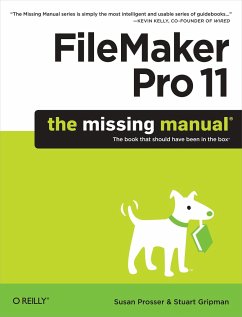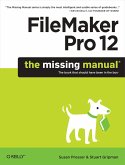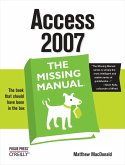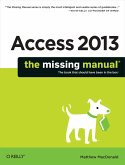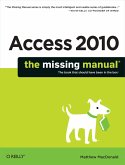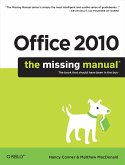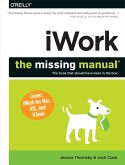Schade – dieser Artikel ist leider ausverkauft. Sobald wir wissen, ob und wann der Artikel wieder verfügbar ist, informieren wir Sie an dieser Stelle.
- Broschiertes Buch
- Merkliste
- Auf die Merkliste
- Bewerten Bewerten
- Teilen
- Produkt teilen
- Produkterinnerung
- Produkterinnerung
This hands-on, friendly guide shows you how to harness FileMaker's power to make your information work for you. With a few mouse clicks, the FileMaker Pro 11 database helps you create and print corporate reports, manage a mailing list, or run your entire business. FileMaker Pro 11: The Missing Manual helps you get started, build your database, and produce results, whether you're running a business, pursuing a hobby, or planning your retirement. It's a thorough, accessible guide for new, non-technical users, as well as those with more experience. Start up: Get your first database up and running…mehr
Andere Kunden interessierten sich auch für
![FileMaker Pro 12: The Missing Manual FileMaker Pro 12: The Missing Manual]() Susan ProsserFileMaker Pro 12: The Missing Manual38,99 €
Susan ProsserFileMaker Pro 12: The Missing Manual38,99 €![Access 2007: The Missing Manual Access 2007: The Missing Manual]() Matthew MacDonaldAccess 2007: The Missing Manual30,99 €
Matthew MacDonaldAccess 2007: The Missing Manual30,99 €![Access 2013: The Missing Manual Access 2013: The Missing Manual]() Matthew MacDonaldAccess 2013: The Missing Manual43,99 €
Matthew MacDonaldAccess 2013: The Missing Manual43,99 €![Access 2010: The Missing Manual Access 2010: The Missing Manual]() Matthew MacDonaldAccess 2010: The Missing Manual34,99 €
Matthew MacDonaldAccess 2010: The Missing Manual34,99 €![Office 2010: The Missing Manual Office 2010: The Missing Manual]() Nancy ConnerOffice 2010: The Missing Manual34,99 €
Nancy ConnerOffice 2010: The Missing Manual34,99 €![Photoshop Elements 11: The Missing Manual Photoshop Elements 11: The Missing Manual]() Barbara BrundagePhotoshop Elements 11: The Missing Manual38,99 €
Barbara BrundagePhotoshop Elements 11: The Missing Manual38,99 €![Iwork: The Missing Manual Iwork: The Missing Manual]() Jessica ThornsbyIwork: The Missing Manual43,99 €
Jessica ThornsbyIwork: The Missing Manual43,99 €
This hands-on, friendly guide shows you how to harness FileMaker's power to make your information work for you. With a few mouse clicks, the FileMaker Pro 11 database helps you create and print corporate reports, manage a mailing list, or run your entire business. FileMaker Pro 11: The Missing Manual helps you get started, build your database, and produce results, whether you're running a business, pursuing a hobby, or planning your retirement. It's a thorough, accessible guide for new, non-technical users, as well as those with more experience.
Start up: Get your first database up and running in minutes
Catalog your data: Organize contacts, to-do items, and product information with speedy data-entry and sorting tools Create professional documents: Publish reports, invoices, and more, with ease
Add visual power and clarity: Create colorful charts to illustrate and summarize your data
Harness processing power: Crunch numbers and search text with dozens of built-in formulas
Learn advanced topics: Explore the high-level features of FileMaker Pro Advanced and FileMaker Server
Start up: Get your first database up and running in minutes
Catalog your data: Organize contacts, to-do items, and product information with speedy data-entry and sorting tools Create professional documents: Publish reports, invoices, and more, with ease
Add visual power and clarity: Create colorful charts to illustrate and summarize your data
Harness processing power: Crunch numbers and search text with dozens of built-in formulas
Learn advanced topics: Explore the high-level features of FileMaker Pro Advanced and FileMaker Server
Produktdetails
- Produktdetails
- the missing manual
- Verlag: O'Reilly Media
- Seitenzahl: 915
- Erscheinungstermin: 29. Juni 2010
- Englisch
- Abmessung: 236mm x 179mm x 45mm
- Gewicht: 1290g
- ISBN-13: 9781449382599
- ISBN-10: 1449382592
- Artikelnr.: 29204227
- Herstellerkennzeichnung
- Libri GmbH
- Europaallee 1
- 36244 Bad Hersfeld
- gpsr@libri.de
- the missing manual
- Verlag: O'Reilly Media
- Seitenzahl: 915
- Erscheinungstermin: 29. Juni 2010
- Englisch
- Abmessung: 236mm x 179mm x 45mm
- Gewicht: 1290g
- ISBN-13: 9781449382599
- ISBN-10: 1449382592
- Artikelnr.: 29204227
- Herstellerkennzeichnung
- Libri GmbH
- Europaallee 1
- 36244 Bad Hersfeld
- gpsr@libri.de
Susan Prosser is a reformed journalist who's stopped trying to bring information to the people and now helps them manage the data they already have. She is a FileMaker Certified Developer and has developed FileMaker databases for 12 years, and also trains and writes curricula for other developers. Stuart Gripman is the founder of Crooked Arm Corp, a full-service FileMaker Pro consulting and development firm based in Berkeley, California. A FileMaker Certified Developer, he has written for both Macworld and MacLife.
The Missing Credits
About the Authors
About the Creative Team
Acknowledgments
The Missing Manual Series
Introduction
Why FileMaker Pro?
What's New in FileMaker Pro 11
The Very Basics
About This Book
Part one: Getting Started with FileMaker
Chapter 1: Working with a Database
1.1 A Very Quick Database Tour
1.2 Opening and Closing Database Files
1.3 Adding Data to Your Database
1.4 Navigating Your Database
1.5 Finding Records
1.6 Sorting Records
1.7 Same Database, Different Views
1.8 Saving Your Database
1.9 Using FileMaker's Help Menu
Chapter 2: Organizing and Editing Records
2.1 Views
2.2 Advanced Find Techniques
2.3 Editing What's in Your Fields
2.4 Changing Text Appearance
2.5 Checking Spelling
2.6 Preview Mode and Printing
Part two: Building Your First Database
Chapter 3: Creating a Custom Database
3.1 Creating a New Database
3.2 Creating and Managing Fields in Table View
3.3 Understanding Layouts
3.4 Customizing a Layout
3.5 Creating a New Layout
3.6 Arrange and Align Tools
Chapter 4: Adding Power to Your Database
4.1 Creating a Simple Calculation
4.2 Creating a Related Table
4.3 Creating and Using Portals
4.4 Using Tab Controls
4.5 Adding Merge Fields
4.6 Writing a Basic Script
4.7 Creating a Dynamic Report with the Assistant
4.8 Creating a Trailing Group Report
4.9 Changing the Default Account
4.10 Summing Up
Part three: Thinking Like a Developer
Chapter 5: Creating and Managing a Relational Database
5.1 Understanding Relational Databases
5.2 Modeling Your Database
5.3 Creating a Relational Database
5.4 Using Relational Database Power
5.5 Lookups
5.6 Reviewing Relationship Concepts
Chapter 6: Field Options
6.1 Understanding Field Types
6.2 Auto-Enter Field Options
6.3 Validation Options
6.4 Storage Options
6.5 Beyond Text: Container Fields
Chapter 7: Layout Tools
7.1 Layout Parts
7.2 Layout Types
7.3 The Inspector's Data Tab
7.4 Advanced Field Controls
7.5 Data Formatting
7.6 Buttons
7.7 Tab Order
7.8 Merge Fields
7.9 Merge Variables
7.10 Tooltips
7.11 Autoresizing
7.12 Creating Layouts for Printing
Chapter 8: Understanding Calculations
8.1 Understanding Calculations
8.2 The Structure of a Calculation
8.3 Using a Related Field in a Calculation
8.4 Understanding the Specify Calculation Dialog Box
8.5 Auto-Enter Calculations
8.6 Validate Data Entry with a Calculation
8.7 Replacing Data Using a Calculation
8.8 Comments
Chapter 9: More Calculations and Data Types
9.1 Number Crunching Calculations
9.2 Going Beyond Basic Calculations
9.3 Text Calculations
9.4 Date and Time Calculations
9.5 Containers in Calculations
Chapter 10: Understanding Scripts
10.1 Understanding Scripts
10.2 Your First Script
10.3 Shortcuts to the Edit Script Window
10.4 The Importance of the Layout
10.5 Running Scripts
10.6 Organizing Your Scripts
10.7 Branching and Looping in Scripts
10.8 Script Triggers
Chapter 11: Exploring Script Steps
11.1 Go to Layout
11.2 Go to Object
11.3 Scripting for Fields
11.4 Working with Records
11.5 Finding Records
11.6 Sorting Records
11.7 Working with Windows
11.8 Working with Files
11.9 Printing
11.10 Other Script Steps
Part four: Becoming a Power Developer
Chapter 12: Applying Developer Utilities
12.1 Copying and Pasting Database Structure
12.2 Script Debugger
12.3 The Data Viewer
12.4 Disable Script Steps
12.5 The Database Design Report
12.6 Custom Functions
12.7 Custom Menus
12.8 Developer Utilities
12.9 File Maintenance
Chapter 13: Advanced Relationship Techniques
13.1 Advanced Relationships
13.2 Portal Filtering
13.3 Understanding Table Occurrences
13.4 Table Occurrence Groups
13.5 Understanding Graph Arrangements
13.6 Connecting Database Files
13.7 Using Multiple Relationship Techniques
Chapter 14: Reporting and Analysis
14.1 Summary Fields and Sub-summary Parts
14.2 Web Viewer Objects
14.3 Conditional Formatting
14.4 Basic Charting (Found Set Charts)
14.5 Chart Formatting
14.6 Charting and Reports
14.7 Advanced Charting
Chapter 15: Advanced Calculations
15.1 Understanding Boolean Functions
15.2 Using Storage Options
15.3 Logical Functions
15.4 The Let() Function and Variables
15.5 Recursion
15.6 Plug-Ins
Chapter 16: Advanced Scripting
16.1 Commenting Scripts
16.2 Importing Scripts
16.3 Communicating with Database Users
16.4 Organizing Complex Scripts
16.5 Script Parameters
16.6 Script Variables
16.7 Handling Errors
16.8 Advanced Script Triggers
16.9 Putting a Complex Script Together
Part five: Integration and Security
Chapter 17: Sharing Your Database
17.1 FileMaker Network Sharing
17.2 Sharing over the Internet
17.3 FileMaker Server
17.4 Server Hardware
Chapter 18: Adding Security
18.1 How Security Works
18.2 Privilege Sets
18.3 Managing Accounts
18.4 Extended Privileges
18.5 Managing External File Access
18.6 Scripts and Security
Chapter 19: Sharing Data with Other Systems
19.1 Sharing Your Data with Others
19.2 Snapshot Link
19.3 External SQL Sources
19.4 Exporting Data
19.5 Importing Data
19.6 Import Data Sources
19.7 Importing and Exporting in a Script
Part six: Appendixes
Getting Help
Getting Help from FileMaker Pro
FileMaker's Installed Extras
The Quick Start Screen
Getting Help from the Community
FileMaker Error Codes
About the Authors
About the Creative Team
Acknowledgments
The Missing Manual Series
Introduction
Why FileMaker Pro?
What's New in FileMaker Pro 11
The Very Basics
About This Book
Part one: Getting Started with FileMaker
Chapter 1: Working with a Database
1.1 A Very Quick Database Tour
1.2 Opening and Closing Database Files
1.3 Adding Data to Your Database
1.4 Navigating Your Database
1.5 Finding Records
1.6 Sorting Records
1.7 Same Database, Different Views
1.8 Saving Your Database
1.9 Using FileMaker's Help Menu
Chapter 2: Organizing and Editing Records
2.1 Views
2.2 Advanced Find Techniques
2.3 Editing What's in Your Fields
2.4 Changing Text Appearance
2.5 Checking Spelling
2.6 Preview Mode and Printing
Part two: Building Your First Database
Chapter 3: Creating a Custom Database
3.1 Creating a New Database
3.2 Creating and Managing Fields in Table View
3.3 Understanding Layouts
3.4 Customizing a Layout
3.5 Creating a New Layout
3.6 Arrange and Align Tools
Chapter 4: Adding Power to Your Database
4.1 Creating a Simple Calculation
4.2 Creating a Related Table
4.3 Creating and Using Portals
4.4 Using Tab Controls
4.5 Adding Merge Fields
4.6 Writing a Basic Script
4.7 Creating a Dynamic Report with the Assistant
4.8 Creating a Trailing Group Report
4.9 Changing the Default Account
4.10 Summing Up
Part three: Thinking Like a Developer
Chapter 5: Creating and Managing a Relational Database
5.1 Understanding Relational Databases
5.2 Modeling Your Database
5.3 Creating a Relational Database
5.4 Using Relational Database Power
5.5 Lookups
5.6 Reviewing Relationship Concepts
Chapter 6: Field Options
6.1 Understanding Field Types
6.2 Auto-Enter Field Options
6.3 Validation Options
6.4 Storage Options
6.5 Beyond Text: Container Fields
Chapter 7: Layout Tools
7.1 Layout Parts
7.2 Layout Types
7.3 The Inspector's Data Tab
7.4 Advanced Field Controls
7.5 Data Formatting
7.6 Buttons
7.7 Tab Order
7.8 Merge Fields
7.9 Merge Variables
7.10 Tooltips
7.11 Autoresizing
7.12 Creating Layouts for Printing
Chapter 8: Understanding Calculations
8.1 Understanding Calculations
8.2 The Structure of a Calculation
8.3 Using a Related Field in a Calculation
8.4 Understanding the Specify Calculation Dialog Box
8.5 Auto-Enter Calculations
8.6 Validate Data Entry with a Calculation
8.7 Replacing Data Using a Calculation
8.8 Comments
Chapter 9: More Calculations and Data Types
9.1 Number Crunching Calculations
9.2 Going Beyond Basic Calculations
9.3 Text Calculations
9.4 Date and Time Calculations
9.5 Containers in Calculations
Chapter 10: Understanding Scripts
10.1 Understanding Scripts
10.2 Your First Script
10.3 Shortcuts to the Edit Script Window
10.4 The Importance of the Layout
10.5 Running Scripts
10.6 Organizing Your Scripts
10.7 Branching and Looping in Scripts
10.8 Script Triggers
Chapter 11: Exploring Script Steps
11.1 Go to Layout
11.2 Go to Object
11.3 Scripting for Fields
11.4 Working with Records
11.5 Finding Records
11.6 Sorting Records
11.7 Working with Windows
11.8 Working with Files
11.9 Printing
11.10 Other Script Steps
Part four: Becoming a Power Developer
Chapter 12: Applying Developer Utilities
12.1 Copying and Pasting Database Structure
12.2 Script Debugger
12.3 The Data Viewer
12.4 Disable Script Steps
12.5 The Database Design Report
12.6 Custom Functions
12.7 Custom Menus
12.8 Developer Utilities
12.9 File Maintenance
Chapter 13: Advanced Relationship Techniques
13.1 Advanced Relationships
13.2 Portal Filtering
13.3 Understanding Table Occurrences
13.4 Table Occurrence Groups
13.5 Understanding Graph Arrangements
13.6 Connecting Database Files
13.7 Using Multiple Relationship Techniques
Chapter 14: Reporting and Analysis
14.1 Summary Fields and Sub-summary Parts
14.2 Web Viewer Objects
14.3 Conditional Formatting
14.4 Basic Charting (Found Set Charts)
14.5 Chart Formatting
14.6 Charting and Reports
14.7 Advanced Charting
Chapter 15: Advanced Calculations
15.1 Understanding Boolean Functions
15.2 Using Storage Options
15.3 Logical Functions
15.4 The Let() Function and Variables
15.5 Recursion
15.6 Plug-Ins
Chapter 16: Advanced Scripting
16.1 Commenting Scripts
16.2 Importing Scripts
16.3 Communicating with Database Users
16.4 Organizing Complex Scripts
16.5 Script Parameters
16.6 Script Variables
16.7 Handling Errors
16.8 Advanced Script Triggers
16.9 Putting a Complex Script Together
Part five: Integration and Security
Chapter 17: Sharing Your Database
17.1 FileMaker Network Sharing
17.2 Sharing over the Internet
17.3 FileMaker Server
17.4 Server Hardware
Chapter 18: Adding Security
18.1 How Security Works
18.2 Privilege Sets
18.3 Managing Accounts
18.4 Extended Privileges
18.5 Managing External File Access
18.6 Scripts and Security
Chapter 19: Sharing Data with Other Systems
19.1 Sharing Your Data with Others
19.2 Snapshot Link
19.3 External SQL Sources
19.4 Exporting Data
19.5 Importing Data
19.6 Import Data Sources
19.7 Importing and Exporting in a Script
Part six: Appendixes
Getting Help
Getting Help from FileMaker Pro
FileMaker's Installed Extras
The Quick Start Screen
Getting Help from the Community
FileMaker Error Codes
The Missing Credits
About the Authors
About the Creative Team
Acknowledgments
The Missing Manual Series
Introduction
Why FileMaker Pro?
What's New in FileMaker Pro 11
The Very Basics
About This Book
Part one: Getting Started with FileMaker
Chapter 1: Working with a Database
1.1 A Very Quick Database Tour
1.2 Opening and Closing Database Files
1.3 Adding Data to Your Database
1.4 Navigating Your Database
1.5 Finding Records
1.6 Sorting Records
1.7 Same Database, Different Views
1.8 Saving Your Database
1.9 Using FileMaker's Help Menu
Chapter 2: Organizing and Editing Records
2.1 Views
2.2 Advanced Find Techniques
2.3 Editing What's in Your Fields
2.4 Changing Text Appearance
2.5 Checking Spelling
2.6 Preview Mode and Printing
Part two: Building Your First Database
Chapter 3: Creating a Custom Database
3.1 Creating a New Database
3.2 Creating and Managing Fields in Table View
3.3 Understanding Layouts
3.4 Customizing a Layout
3.5 Creating a New Layout
3.6 Arrange and Align Tools
Chapter 4: Adding Power to Your Database
4.1 Creating a Simple Calculation
4.2 Creating a Related Table
4.3 Creating and Using Portals
4.4 Using Tab Controls
4.5 Adding Merge Fields
4.6 Writing a Basic Script
4.7 Creating a Dynamic Report with the Assistant
4.8 Creating a Trailing Group Report
4.9 Changing the Default Account
4.10 Summing Up
Part three: Thinking Like a Developer
Chapter 5: Creating and Managing a Relational Database
5.1 Understanding Relational Databases
5.2 Modeling Your Database
5.3 Creating a Relational Database
5.4 Using Relational Database Power
5.5 Lookups
5.6 Reviewing Relationship Concepts
Chapter 6: Field Options
6.1 Understanding Field Types
6.2 Auto-Enter Field Options
6.3 Validation Options
6.4 Storage Options
6.5 Beyond Text: Container Fields
Chapter 7: Layout Tools
7.1 Layout Parts
7.2 Layout Types
7.3 The Inspector's Data Tab
7.4 Advanced Field Controls
7.5 Data Formatting
7.6 Buttons
7.7 Tab Order
7.8 Merge Fields
7.9 Merge Variables
7.10 Tooltips
7.11 Autoresizing
7.12 Creating Layouts for Printing
Chapter 8: Understanding Calculations
8.1 Understanding Calculations
8.2 The Structure of a Calculation
8.3 Using a Related Field in a Calculation
8.4 Understanding the Specify Calculation Dialog Box
8.5 Auto-Enter Calculations
8.6 Validate Data Entry with a Calculation
8.7 Replacing Data Using a Calculation
8.8 Comments
Chapter 9: More Calculations and Data Types
9.1 Number Crunching Calculations
9.2 Going Beyond Basic Calculations
9.3 Text Calculations
9.4 Date and Time Calculations
9.5 Containers in Calculations
Chapter 10: Understanding Scripts
10.1 Understanding Scripts
10.2 Your First Script
10.3 Shortcuts to the Edit Script Window
10.4 The Importance of the Layout
10.5 Running Scripts
10.6 Organizing Your Scripts
10.7 Branching and Looping in Scripts
10.8 Script Triggers
Chapter 11: Exploring Script Steps
11.1 Go to Layout
11.2 Go to Object
11.3 Scripting for Fields
11.4 Working with Records
11.5 Finding Records
11.6 Sorting Records
11.7 Working with Windows
11.8 Working with Files
11.9 Printing
11.10 Other Script Steps
Part four: Becoming a Power Developer
Chapter 12: Applying Developer Utilities
12.1 Copying and Pasting Database Structure
12.2 Script Debugger
12.3 The Data Viewer
12.4 Disable Script Steps
12.5 The Database Design Report
12.6 Custom Functions
12.7 Custom Menus
12.8 Developer Utilities
12.9 File Maintenance
Chapter 13: Advanced Relationship Techniques
13.1 Advanced Relationships
13.2 Portal Filtering
13.3 Understanding Table Occurrences
13.4 Table Occurrence Groups
13.5 Understanding Graph Arrangements
13.6 Connecting Database Files
13.7 Using Multiple Relationship Techniques
Chapter 14: Reporting and Analysis
14.1 Summary Fields and Sub-summary Parts
14.2 Web Viewer Objects
14.3 Conditional Formatting
14.4 Basic Charting (Found Set Charts)
14.5 Chart Formatting
14.6 Charting and Reports
14.7 Advanced Charting
Chapter 15: Advanced Calculations
15.1 Understanding Boolean Functions
15.2 Using Storage Options
15.3 Logical Functions
15.4 The Let() Function and Variables
15.5 Recursion
15.6 Plug-Ins
Chapter 16: Advanced Scripting
16.1 Commenting Scripts
16.2 Importing Scripts
16.3 Communicating with Database Users
16.4 Organizing Complex Scripts
16.5 Script Parameters
16.6 Script Variables
16.7 Handling Errors
16.8 Advanced Script Triggers
16.9 Putting a Complex Script Together
Part five: Integration and Security
Chapter 17: Sharing Your Database
17.1 FileMaker Network Sharing
17.2 Sharing over the Internet
17.3 FileMaker Server
17.4 Server Hardware
Chapter 18: Adding Security
18.1 How Security Works
18.2 Privilege Sets
18.3 Managing Accounts
18.4 Extended Privileges
18.5 Managing External File Access
18.6 Scripts and Security
Chapter 19: Sharing Data with Other Systems
19.1 Sharing Your Data with Others
19.2 Snapshot Link
19.3 External SQL Sources
19.4 Exporting Data
19.5 Importing Data
19.6 Import Data Sources
19.7 Importing and Exporting in a Script
Part six: Appendixes
Getting Help
Getting Help from FileMaker Pro
FileMaker's Installed Extras
The Quick Start Screen
Getting Help from the Community
FileMaker Error Codes
About the Authors
About the Creative Team
Acknowledgments
The Missing Manual Series
Introduction
Why FileMaker Pro?
What's New in FileMaker Pro 11
The Very Basics
About This Book
Part one: Getting Started with FileMaker
Chapter 1: Working with a Database
1.1 A Very Quick Database Tour
1.2 Opening and Closing Database Files
1.3 Adding Data to Your Database
1.4 Navigating Your Database
1.5 Finding Records
1.6 Sorting Records
1.7 Same Database, Different Views
1.8 Saving Your Database
1.9 Using FileMaker's Help Menu
Chapter 2: Organizing and Editing Records
2.1 Views
2.2 Advanced Find Techniques
2.3 Editing What's in Your Fields
2.4 Changing Text Appearance
2.5 Checking Spelling
2.6 Preview Mode and Printing
Part two: Building Your First Database
Chapter 3: Creating a Custom Database
3.1 Creating a New Database
3.2 Creating and Managing Fields in Table View
3.3 Understanding Layouts
3.4 Customizing a Layout
3.5 Creating a New Layout
3.6 Arrange and Align Tools
Chapter 4: Adding Power to Your Database
4.1 Creating a Simple Calculation
4.2 Creating a Related Table
4.3 Creating and Using Portals
4.4 Using Tab Controls
4.5 Adding Merge Fields
4.6 Writing a Basic Script
4.7 Creating a Dynamic Report with the Assistant
4.8 Creating a Trailing Group Report
4.9 Changing the Default Account
4.10 Summing Up
Part three: Thinking Like a Developer
Chapter 5: Creating and Managing a Relational Database
5.1 Understanding Relational Databases
5.2 Modeling Your Database
5.3 Creating a Relational Database
5.4 Using Relational Database Power
5.5 Lookups
5.6 Reviewing Relationship Concepts
Chapter 6: Field Options
6.1 Understanding Field Types
6.2 Auto-Enter Field Options
6.3 Validation Options
6.4 Storage Options
6.5 Beyond Text: Container Fields
Chapter 7: Layout Tools
7.1 Layout Parts
7.2 Layout Types
7.3 The Inspector's Data Tab
7.4 Advanced Field Controls
7.5 Data Formatting
7.6 Buttons
7.7 Tab Order
7.8 Merge Fields
7.9 Merge Variables
7.10 Tooltips
7.11 Autoresizing
7.12 Creating Layouts for Printing
Chapter 8: Understanding Calculations
8.1 Understanding Calculations
8.2 The Structure of a Calculation
8.3 Using a Related Field in a Calculation
8.4 Understanding the Specify Calculation Dialog Box
8.5 Auto-Enter Calculations
8.6 Validate Data Entry with a Calculation
8.7 Replacing Data Using a Calculation
8.8 Comments
Chapter 9: More Calculations and Data Types
9.1 Number Crunching Calculations
9.2 Going Beyond Basic Calculations
9.3 Text Calculations
9.4 Date and Time Calculations
9.5 Containers in Calculations
Chapter 10: Understanding Scripts
10.1 Understanding Scripts
10.2 Your First Script
10.3 Shortcuts to the Edit Script Window
10.4 The Importance of the Layout
10.5 Running Scripts
10.6 Organizing Your Scripts
10.7 Branching and Looping in Scripts
10.8 Script Triggers
Chapter 11: Exploring Script Steps
11.1 Go to Layout
11.2 Go to Object
11.3 Scripting for Fields
11.4 Working with Records
11.5 Finding Records
11.6 Sorting Records
11.7 Working with Windows
11.8 Working with Files
11.9 Printing
11.10 Other Script Steps
Part four: Becoming a Power Developer
Chapter 12: Applying Developer Utilities
12.1 Copying and Pasting Database Structure
12.2 Script Debugger
12.3 The Data Viewer
12.4 Disable Script Steps
12.5 The Database Design Report
12.6 Custom Functions
12.7 Custom Menus
12.8 Developer Utilities
12.9 File Maintenance
Chapter 13: Advanced Relationship Techniques
13.1 Advanced Relationships
13.2 Portal Filtering
13.3 Understanding Table Occurrences
13.4 Table Occurrence Groups
13.5 Understanding Graph Arrangements
13.6 Connecting Database Files
13.7 Using Multiple Relationship Techniques
Chapter 14: Reporting and Analysis
14.1 Summary Fields and Sub-summary Parts
14.2 Web Viewer Objects
14.3 Conditional Formatting
14.4 Basic Charting (Found Set Charts)
14.5 Chart Formatting
14.6 Charting and Reports
14.7 Advanced Charting
Chapter 15: Advanced Calculations
15.1 Understanding Boolean Functions
15.2 Using Storage Options
15.3 Logical Functions
15.4 The Let() Function and Variables
15.5 Recursion
15.6 Plug-Ins
Chapter 16: Advanced Scripting
16.1 Commenting Scripts
16.2 Importing Scripts
16.3 Communicating with Database Users
16.4 Organizing Complex Scripts
16.5 Script Parameters
16.6 Script Variables
16.7 Handling Errors
16.8 Advanced Script Triggers
16.9 Putting a Complex Script Together
Part five: Integration and Security
Chapter 17: Sharing Your Database
17.1 FileMaker Network Sharing
17.2 Sharing over the Internet
17.3 FileMaker Server
17.4 Server Hardware
Chapter 18: Adding Security
18.1 How Security Works
18.2 Privilege Sets
18.3 Managing Accounts
18.4 Extended Privileges
18.5 Managing External File Access
18.6 Scripts and Security
Chapter 19: Sharing Data with Other Systems
19.1 Sharing Your Data with Others
19.2 Snapshot Link
19.3 External SQL Sources
19.4 Exporting Data
19.5 Importing Data
19.6 Import Data Sources
19.7 Importing and Exporting in a Script
Part six: Appendixes
Getting Help
Getting Help from FileMaker Pro
FileMaker's Installed Extras
The Quick Start Screen
Getting Help from the Community
FileMaker Error Codes

